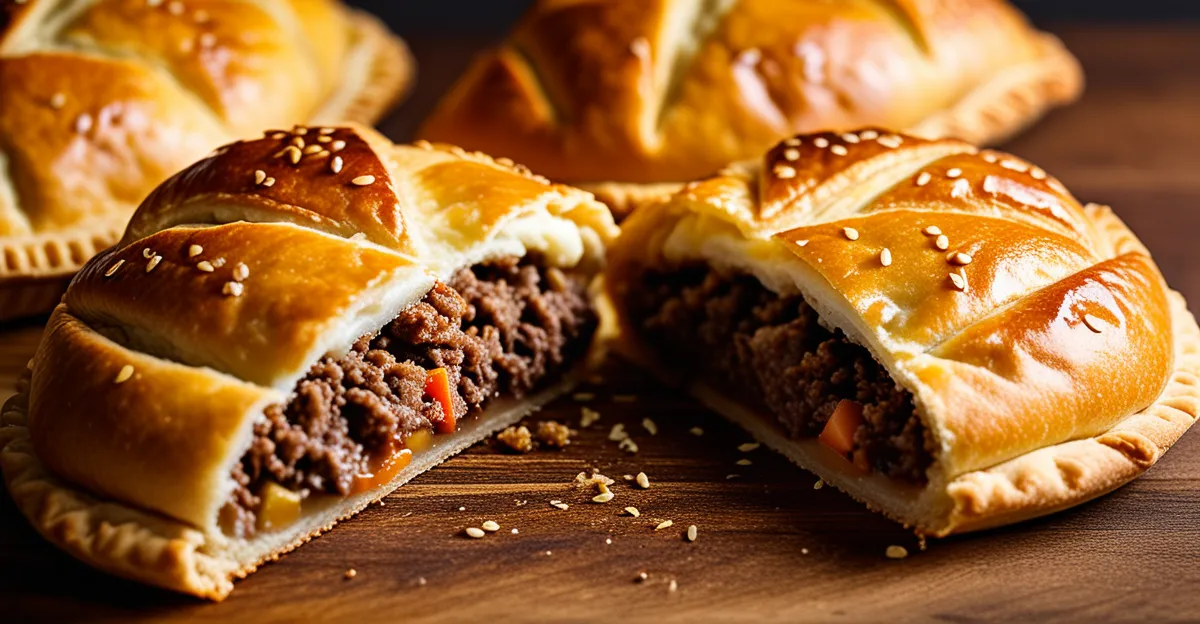Essential Elements of Cornish Pasty Texture
Achieving the perfect Cornish pasty texture hinges on striking the right balance between flakiness and structural integrity. The hallmark of an ideal Cornish pasty texture is a pastry that is both tender and flaky yet resilient enough to hold its hearty filling without disintegrating. This balance ensures a satisfying mouthfeel that is neither greasy nor tough.
Why is this balance so critical? Flakiness is developed through the layering of fat within the dough, creating crisp, delicate layers that give the pasty its character. However, if the texture becomes too crumbly, the pasty will fall apart during eating or transport. Conversely, too firm or dense a crust leads to a tough eating experience, detracting from what makes a Cornish pasty special.
Also to read : How do you prepare a traditional Scottish haggis with neeps and tatties?
Traditional expectations emphasize a golden, slightly crumbly crust that breaks apart easily but remains robust. The interplay of these key elements—fat distribution, dough hydration, and gentle handling—define the Cornish pasty texture. Mastering these fundamentals results in a pasty that pleases both the palate and the practical needs of a portable meal.
Pastry Dough Preparation Techniques
Crafting the perfect Cornish pasty dough starts with precise pastry dough preparation. Cold ingredients are vital; chilling the fat and water prevents premature fat melting, preserving the pockets responsible for flakiness. Minimal mixing is equally important. Overworking the dough develops gluten excessively, yielding a tough crust rather than the tender, flaky texture that defines a perfect pasty.
In parallel : How can you prepare a comforting bubble and squeak at home?
Choosing the right flour and fat ratios significantly influences the dough’s final consistency. A balance between strong bread flour for structure and softer pastry flour can be employed, but the fat ratio must be sufficient to create those signature tender layers. Usually, around 20-25% fat by weight of flour works well.
Incorporating fat correctly is central to developing the texture. Techniques such as rubbing the fat into the flour until it resembles coarse breadcrumbs, or cutting chilled fat into small cubes to scatter and fold, create flakes that puff during baking. This layering—one of the key elements in defining Cornish pasty texture—ensures a crust that is simultaneously crispy and resilient.
Attention to these pastry dough preparation details lays the foundation for that sought-after flaky, structured pastry essential for an authentic Cornish pasty experience.
Handling and Shaping for Optimal Results
Proper dough handling is crucial to preserve the delicate balance needed for the flawless Cornish pasty texture. Overworking the dough develops gluten excessively, resulting in a tough crust rather than the tender flakiness expected of a perfect pasty. To avoid this, gentle folding and minimal kneading during pasty shaping are essential.
When rolling the dough, aim for an even thickness, typically around 3–4 mm. This consistency ensures the pasty cooks evenly and maintains structural integrity throughout baking and eating. Uneven thickness can cause weak spots prone to breaking or sogginess.
Crimping the edges correctly is another key element of successful pasty shaping. A traditional “D” shape with a well-sealed crimp prevents filling leakage while allowing slight expansion as the pasty bakes. Using a firm but delicate touch ensures the roll edge holds without compressing the dough too tightly, which can cause a tough bite.
Mastering these dough handling and shaping techniques supports the characteristic golden, flaky crust while safeguarding the textures that make an authentic Cornish pasty so beloved.
Managing Moisture in Fillings
Controlling filling moisture is crucial to achieving the classic Cornish pasty texture. Excess water from fillings can seep into the pastry, causing sogginess that undermines the crust’s flakiness and structure. To prevent this, reducing moisture through proper ingredient choices and preparatory steps is essential.
One effective method for moisture control is to precook or drain high-water-content ingredients like potatoes or swedes before filling. This removes excess liquid while preserving the hearty flavors that define the perfect pasty. Additionally, using slightly drier cuts of meat and finely chopping vegetables allows even cooking with minimal water release.
Balancing juicy fillings with pastry stability demands attention to ratios and texture. Incorporating ingredients such as breadcrumbs or a light dusting of flour within the filling helps absorb moisture without affecting taste. These key elements prevent the wet fillings from softening the dough prematurely.
Maintaining controlled filling moisture safeguards the textural harmony critical to an authentic pasty. This focus ensures the crust remains crisp and resilient, complementing the satisfying, hearty interior expected of a traditional Cornish pasty.
Baking Temperatures and Timing
Mastering the baking temperature and timing is crucial for achieving the iconic Cornish pasty texture that combines a golden crust with a tender interior. The ideal oven temperature typically ranges between 180°C to 200°C (356°F to 392°F). This range fosters even heat distribution, allowing the pastry to rise, crisp, and brown without burning or undercooking.
Baking too hot can cause the fat in the pastry dough to melt too quickly, resulting in a greasy or tough crust. Conversely, baking at too low a temperature leads to a soggy or doughy pasty, as the filling releases moisture before the crust firms up. Timing usually falls within 45 to 55 minutes depending on oven performance and pasty size, ensuring the filling cooks through while the crust gains that sought-after flakiness.
Adjusting baking parameters for home ovens is often necessary due to temperature inconsistencies. Using an oven thermometer to verify true heat can prevent surprises. Rotating pasties midway encourages even baking and prevents uneven browning or cracking.
In short, precise control of baking temperature and baking timing constitutes a fundamental key element to producing the perfect pasty. Getting these settings right safeguards the textural harmony that defines an authentic Cornish pasty experience.
Troubleshooting Common Texture Problems
When confronting texture troubleshooting in a Cornish pasty, identifying whether the pastry is tough, soggy, or splitting is essential for effective correction. Tough pastry often results from overworking the dough, which develops excessive gluten, leading to a chewy, dense crust. To fix this, reduce mixing time and handle the pastry dough more gently. Ensuring fat is well incorporated and keeping ingredients cold also prevents toughness.
Soggy pastry typically occurs when excess moisture from the filling seeps into the crust or when baking temperature and timing are inadequate. To address soggy pastry, control filling moisture by draining or precooking wet ingredients and use absorbent fillers like breadcrumbs. Additionally, bake at the recommended temperatures and avoid opening the oven frequently to keep heat consistent.
Splitting pasties usually indicate improper pasty shaping or uneven rolling thickness. Over-tight crimping or thin edges can crack during baking. Maintain even dough thickness, around 3–4 mm, and crimp delicately to seal without compressing too firmly. Mid-baking adjustments such as rotating trays for even heat can also prevent splitting. Recognising these issues early allows for corrections that preserve the perfect pasty texture.
Insights from Cornish Bakers and Tradition
Cornish baking tips emphasize the critical role of respecting tradition in achieving the authentic Cornish pasty texture. Expert advice from regional bakers consistently highlights gentle dough handling and precise fat incorporation as foundational to a perfect pasty. They caution against shortcuts that risk compromising the signature flakiness and resilience.
Traditional pasty makers underscore that maintaining cold ingredients and minimal mixing during pastry dough preparation preserves the layered fat pockets vital for flakiness. They also stress the importance of even rolling thickness and meticulous crimping for structural integrity, which ensures the filling stays contained while allowing the crust to bake evenly.
A key takeaway from Cornish experts is the balance between innovation and heritage. While modern ovens and ingredient substitutions are common, adhering to time-tested methods in shaping and baking preserves the unique texture that defines a true Cornish pasty. For example, seasoned bakers recommend baking within a narrow temperature range to avoid sogginess or toughness, aligning with traditional wisdom.
Ultimately, these Cornish baking tips remind us that texture mastery lies not only in ingredients but in technique—trusting the process ensures the key elements come together, producing a pasty both delightful to eat and faithful to its roots.









